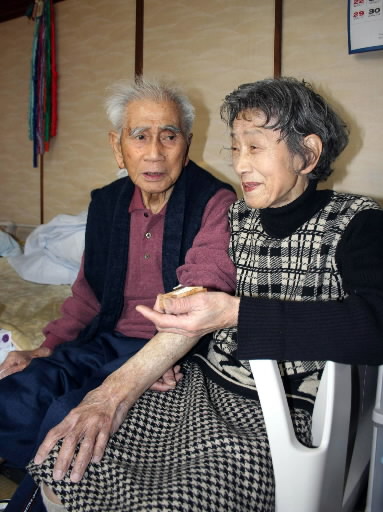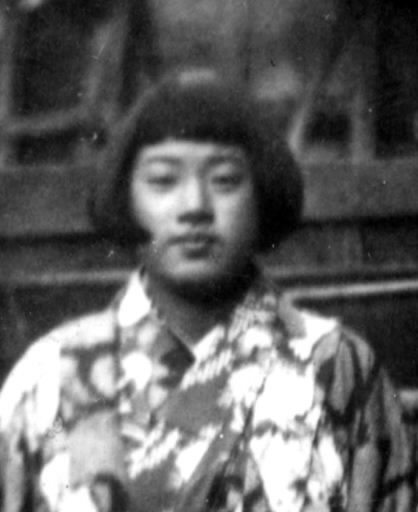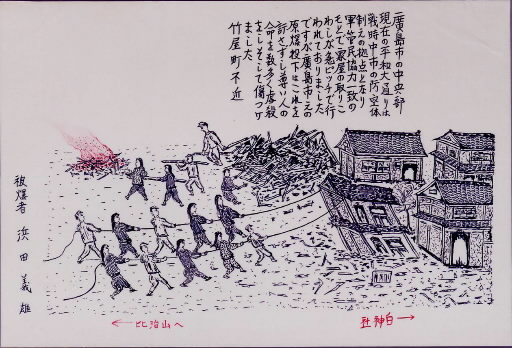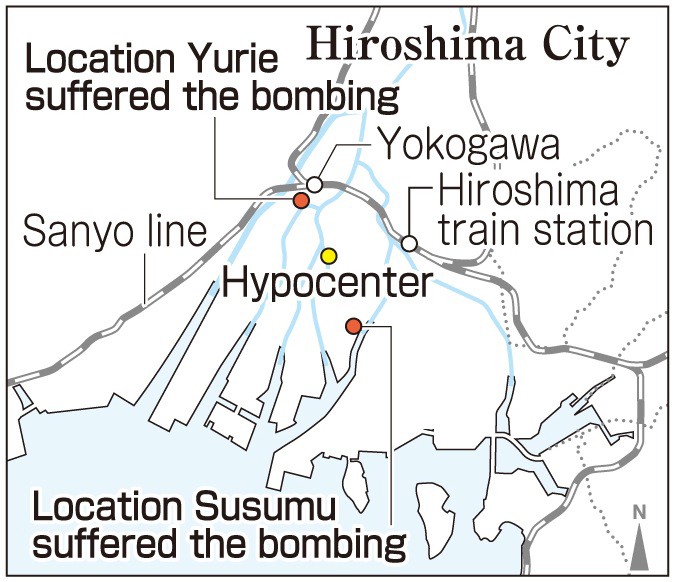Susumu Amato, 85, and his wife Yurie, 83, Minami Ward, Hiroshima
Jun. 25, 2012
Grateful for their survival
Couple relives day of bombing, including death of wife's sister
Each year, as August 6 approaches, Yurie Amato, 83, and her husband Susumu, 85, reaffirm the feeling: "It was a terrible experience, but we're glad we survived." They express gratitude for the lives fate has given them.
Back in August of 1945, Yurie was 17, a second-year student at Hiroshima Second Municipal Girls' High School (now, Funairi High School). On August 6, the day of the atomic bombing, she was working as a mobilized student at a factory in Nishi Ward, about 1.5 kilometers from the hypocenter. Given the task of cleaning canteens, she was standing in front of a mirror, set to tie a towel around her head. At that moment she heard a loud boom and saw a flash of orange. The building shook and then collapsed.
Yurie found herself under the wreckage of the building. She was able to crawl out, but discovered glass fragments stuck in her back and her face. Looking back, she recalled: "In a single moment I was changed into a young girl covered with blood and dust." Her left hand was injured, too, and she couldn't move two of her fingers.
When she returned to her home in Naka Ward, she found that her house had burned to the ground. She was reunited with her anxious mother, Fusa, 63 at the time, at an evacuation site. They were unable to find her sister, Hideko, 36, who was working as a hairdresser.
Hideko had run a hair salon out of her home, but the house was slated to be dismantled in order to create a fire lane in the event of air raids. Yurie later heard from an acquaintance that, on the morning of August 6, Hideko had gone to a house in the neighborhood to discuss locating a new site for her hair salon. She likely was buried underneath that fallen house.
Yurie and her mother gathered up the bones that seemed to be her sister's remains, wrapping as many as they could with a white cloth. As the father had passed away some time before, Hideko's livelihood had been keeping the family afloat. "I feel sorry for my sister," Yurie said, choking back tears. "She supported our family instead of getting married, then sacrificed her life for the country."
In 1953 she married Susumu, who is also an A-bomb survivor. On the day of the bombing, Susumu was 18 years old and he was working at the Toyo Kogyo factory (now, Mazda, a major automobile maker). After working the night shift, he had a day off on August 6. He was near the Tsurumibashi Bridge, about 1.5 kilometers from the hypocenter, when the bomb exploded. The blast blew him into the air and he landed in the river.
He had severe burns on the left side of his body. No proper medicine was available, though, so he fashioned a home remedy which was rumored to be effective. He mixed bone meal, usually used as fertilizer, with oil and rubbed this concoction onto his burned skin. His body still bears keloid scars today.
Susumu now feels pain in the joints of his legs and he spends most of the day in bed. "It might be hard for young people today to understand our experience," he said. "But atomic bombs and war are evil things."
Yurie recalled her younger days as a teenager, when war shadowed everything around them, and said: "Children today are happy. If they make the effort, their dreams can come true. I hope they'll give it their best." (Sakiko Masuda, Staff Writer)
Building removal: Preventing the spread of fire by creating fire lanes
"Building removal" involved tearing down buildings to prevent fire from spreading in the event of air raids. This practice was undertaken in cities all across Japan during the war. The city of Hiroshima began its own removal efforts in November 1944 by order of the central government. The city demolished structures that were around buildings officials wanted to protect from fire, including City Hall, the Prefectural Government Office, and military facilities.
By law, all citizens were required to help with the war effort. On August 6, 1945, the building removal work was being carried out by mobilized students (of today's junior high school age) as well as groups of adults who were organized according to area of residence or place of work. Many of the people involved in this work were killed by the atomic bomb. An exhibition held at Hiroshima Peace Memorial Museum in 2004 offered a death toll of approximately 5,900 mobilized students, perishing at the sites where they were helping to dismantle buildings.
Museum displays show possessions once owned by the victims, including a lunch box, charred black, and a female student's summer-type school uniform. Hironobu Ochiba, 34, a curator at the museum, said, "When visitors see these items, which are filled with the suffering of the dead and the sorrow of their families, I hope they will feel the horror of war and the importance of peace."
Teenagers’ impressions
Listen to A-bomb experiences
When Yurie said, "During the war, we didn't have anything like a 'springtime of life' in our youth," I realized how blessed we are today.
She told us to learn about what happened in the war. I want to take it upon myself to listen to accounts of the atomic bombing and study about the war. (Nene Takahashi, 16)
The couple's message to us
Though Susumu said, "It might be hard for young people today to understand" and Yuriko told us, "It's painful to bring back these memories," they were kind enough to share their sad experiences in order to convey the cruelty of the war. It made me feel strongly that I have to carry on their conviction that "war should never be waged again." (Junichi Akiyama, 15)
Staff Writer’s Notebook
The register of students who attended Hiroshima Second Municipal Girls' High School is still preserved by Funairi High School. In this register is a notation about Yurie Amato. It says: "As vice-president of the class, she showed a strong sense of responsibility. In December 1944, she received a commendation from the factory where she was working.
" Yurie's younger days were dominated by the war. She was mobilized to work at a military factory and students were too preoccupied with the war effort to study. Apparently, they weren't even permitted to dress up their school uniform with a ribbon when they went to school.
The atomic bombing of August 6, 1945 stole away Yurie's older sister, who had been working as a hairdresser to support the family. As she shared her experience, Yurie's words left a strong impression on the two high school students who interviewed her.
Coincidentally, Yurie was a classmate of Yoshinori Kokubu, who appeared in issue 105 of Peace Seeds, when the two were in elementary school. "It makes me feel lonely that I'm losing the old schoolmates who I can talk with about memories of the war," Yurie said. I hope these two schoolmates can reunite after so many years have passed. (Sakiko Masuda, Staff Writer)
(Originally published on February 14, 2012)
Couple relives day of bombing, including death of wife's sister
Each year, as August 6 approaches, Yurie Amato, 83, and her husband Susumu, 85, reaffirm the feeling: "It was a terrible experience, but we're glad we survived." They express gratitude for the lives fate has given them.
Back in August of 1945, Yurie was 17, a second-year student at Hiroshima Second Municipal Girls' High School (now, Funairi High School). On August 6, the day of the atomic bombing, she was working as a mobilized student at a factory in Nishi Ward, about 1.5 kilometers from the hypocenter. Given the task of cleaning canteens, she was standing in front of a mirror, set to tie a towel around her head. At that moment she heard a loud boom and saw a flash of orange. The building shook and then collapsed.
Yurie found herself under the wreckage of the building. She was able to crawl out, but discovered glass fragments stuck in her back and her face. Looking back, she recalled: "In a single moment I was changed into a young girl covered with blood and dust." Her left hand was injured, too, and she couldn't move two of her fingers.
When she returned to her home in Naka Ward, she found that her house had burned to the ground. She was reunited with her anxious mother, Fusa, 63 at the time, at an evacuation site. They were unable to find her sister, Hideko, 36, who was working as a hairdresser.
Hideko had run a hair salon out of her home, but the house was slated to be dismantled in order to create a fire lane in the event of air raids. Yurie later heard from an acquaintance that, on the morning of August 6, Hideko had gone to a house in the neighborhood to discuss locating a new site for her hair salon. She likely was buried underneath that fallen house.
Yurie and her mother gathered up the bones that seemed to be her sister's remains, wrapping as many as they could with a white cloth. As the father had passed away some time before, Hideko's livelihood had been keeping the family afloat. "I feel sorry for my sister," Yurie said, choking back tears. "She supported our family instead of getting married, then sacrificed her life for the country."
In 1953 she married Susumu, who is also an A-bomb survivor. On the day of the bombing, Susumu was 18 years old and he was working at the Toyo Kogyo factory (now, Mazda, a major automobile maker). After working the night shift, he had a day off on August 6. He was near the Tsurumibashi Bridge, about 1.5 kilometers from the hypocenter, when the bomb exploded. The blast blew him into the air and he landed in the river.
He had severe burns on the left side of his body. No proper medicine was available, though, so he fashioned a home remedy which was rumored to be effective. He mixed bone meal, usually used as fertilizer, with oil and rubbed this concoction onto his burned skin. His body still bears keloid scars today.
Susumu now feels pain in the joints of his legs and he spends most of the day in bed. "It might be hard for young people today to understand our experience," he said. "But atomic bombs and war are evil things."
Yurie recalled her younger days as a teenager, when war shadowed everything around them, and said: "Children today are happy. If they make the effort, their dreams can come true. I hope they'll give it their best." (Sakiko Masuda, Staff Writer)
Hiroshima Insight
Building removal: Preventing the spread of fire by creating fire lanes
"Building removal" involved tearing down buildings to prevent fire from spreading in the event of air raids. This practice was undertaken in cities all across Japan during the war. The city of Hiroshima began its own removal efforts in November 1944 by order of the central government. The city demolished structures that were around buildings officials wanted to protect from fire, including City Hall, the Prefectural Government Office, and military facilities.
By law, all citizens were required to help with the war effort. On August 6, 1945, the building removal work was being carried out by mobilized students (of today's junior high school age) as well as groups of adults who were organized according to area of residence or place of work. Many of the people involved in this work were killed by the atomic bomb. An exhibition held at Hiroshima Peace Memorial Museum in 2004 offered a death toll of approximately 5,900 mobilized students, perishing at the sites where they were helping to dismantle buildings.
Museum displays show possessions once owned by the victims, including a lunch box, charred black, and a female student's summer-type school uniform. Hironobu Ochiba, 34, a curator at the museum, said, "When visitors see these items, which are filled with the suffering of the dead and the sorrow of their families, I hope they will feel the horror of war and the importance of peace."
Teenagers’ impressions
Listen to A-bomb experiences
When Yurie said, "During the war, we didn't have anything like a 'springtime of life' in our youth," I realized how blessed we are today.
She told us to learn about what happened in the war. I want to take it upon myself to listen to accounts of the atomic bombing and study about the war. (Nene Takahashi, 16)
The couple's message to us
Though Susumu said, "It might be hard for young people today to understand" and Yuriko told us, "It's painful to bring back these memories," they were kind enough to share their sad experiences in order to convey the cruelty of the war. It made me feel strongly that I have to carry on their conviction that "war should never be waged again." (Junichi Akiyama, 15)
Staff Writer’s Notebook
The register of students who attended Hiroshima Second Municipal Girls' High School is still preserved by Funairi High School. In this register is a notation about Yurie Amato. It says: "As vice-president of the class, she showed a strong sense of responsibility. In December 1944, she received a commendation from the factory where she was working.
" Yurie's younger days were dominated by the war. She was mobilized to work at a military factory and students were too preoccupied with the war effort to study. Apparently, they weren't even permitted to dress up their school uniform with a ribbon when they went to school.
The atomic bombing of August 6, 1945 stole away Yurie's older sister, who had been working as a hairdresser to support the family. As she shared her experience, Yurie's words left a strong impression on the two high school students who interviewed her.
Coincidentally, Yurie was a classmate of Yoshinori Kokubu, who appeared in issue 105 of Peace Seeds, when the two were in elementary school. "It makes me feel lonely that I'm losing the old schoolmates who I can talk with about memories of the war," Yurie said. I hope these two schoolmates can reunite after so many years have passed. (Sakiko Masuda, Staff Writer)
(Originally published on February 14, 2012)











